Display Advertising - The Ultimate Guide
- Start
- Resources
- Ultimate guides
- Display Advertising
What is display advertising?
Display advertising is a method of advertising that features text, imagery and a link to a clickable advert that directs users to a website where they can learn more about the product or service in question. Display adverts can take many forms, with the more common formats featuring static imagery, animation or video; the latter two more commonly referred to as rich media. Regardless, the core objective always remains the same: when clicked on by a viewer, the ad links back to a company’s website or a dedicated landing page.
The first banner ad appeared on the web in 1994 and was a little rectangular ad for AT&T on the first version of wired.com. Years, and trillions of ads later, the fundamentals of display advertising remain largely the same.
A display ad, or banner ad, is the box or ‘banner’ on a website that stands out from the rest of the website and looks distinctly like an ad. For example, it often features a product image, brand, and call-to-action (CTA). Interested in some examples? Have a look here.
Why should you use display advertising?
/BannerFlow_March2023/images/res-202.jpg)
Research shows that during the first half of 2022, digital display spend was up by 28% year-on-year. According to a study conducted by Insider Intelligence, display ad spend will continue to increase by 15.5% to $165.84 billion in 2023 showcasing the growth of display advertising.
So what is it about display advertising that makes it such an attractive option for digital marketers?
In this chapter, we highlight five key reasons why display advertising is a vital part of any marketing strategy. Including:
- How display advertising can increase brand awareness
- Reach audiences across devices and platforms
- Personalise your approach with contextual and demographic targeting
- Increase ROI with retargeting
- Creativity in your online marketing
1. An important tool for brand awareness
2. Reach your audience like never before
3. Create relevant ads with personalised targeting
4. Increase ROI with retargeting
5. Be creative
What is the difference between native ads and display ads?
Native ads are a more common form of digital advertising and differ in appearance and objective compared to display ads. This year, advertisers are projected to spend around $95 billion on native ads, with the format expected to account for 74% of total ad revenue in the US. But what are the key differences between native ads and display ads?
Whereas display ads are intended to stand out in appearance on a user’s screen to entice them to engage with it, native ads are more subtle, blending into the page itself and appearing as a seamless continuation of the content on screen. If display ads have a hard-sell element to them, native ads are softer and more editorial in appearance.
Get To Know: Native Advertising
- Common examples of native ads include sponsored social media posts, sponsored links within search engine results, or sponsored articles on a media site or online news outlet
- Native ads tend to generate more engagement than display ads, but they perform much better on mobile compared to desktop. On mobile, the click-through rate of a native ad can top 0.38%, whereas on desktop that figures declines by more than half to an average of 0.16%, according to Outbrain.
- Whilst display ads are most effective as part of a retargeting campaign to engage previous visitors to your website, for example, native ads can be directed at new audiences and designed to drive high-quality traffic back to site
- Younger online audiences are more likely to engage with native ads over any other format, according to app samurai, due to their non-intrusive nature and the value that the content provides them
All ad formats present their own challenges and so that is not to say that native ads are king of digital advertising: it all depends on the type of campaign you’re running and the audience you’re hoping to engage.
If your campaign is focused on retargeting audiences that have already interacted with your business before, or a mixture of communities that tend to visit an array of different websites, display ads are likely to be your best option over native ads. But if you wish to be a bit more creative and compelling with your content approach, and you know that your primary audience are likely to visit similar destinations online, native ads can be very rewarding when it comes to ROI.
Step 2: Work with a creative management platform (CMP)
To get the most out of your data – a creative management platform such as Bannerflow provides you with transparency over both your creative production and ad analytics.
Since the production and editing time is reduced to a minimum, there’s virtually nothing stopping you from making real-time updates of your creatives based on their performance.
If you’re interested in learning how a CMP can improve your creative efficiency, take the next step and contact us.
Why is HTML5 the preferred display advertising format?
/BannerFlow_March2023/images/res-203.jpg)
A brief history: Flash, static and HTML5 banners explained
Static banners are the granddaddy of all display advertising, and are non-interactive display ads. Static banners are either .jpg, .pngs or.gif files.
Once, there was also Flash. It offered flexibility in terms of design and interactivity. However, security vulnerabilities, and the fact it required a browser plugin, saw big tech industry players drop support for it.
Finally, in June 2016 Google stopped supporting Flash banner ads and it ceased to be a valid format. Instead another format, HTML5, was crowned the number one advertising format for display advertising – with static ads remaining as the dull older brother.
What is a HTML5 banner ad?
Put simply, a HTML5 banner is an ad that uses the same coding language used to design and control webpages. It applies the latest update of Hypertext Markup Language. HTML5 banners are therefore coded and updatable – and interactive – unlike static banners.
For example, within a HTML5 banner ad, text, images, video, and JavaScript are easily editable, much in the same way as any webpage. Thus basic HTML5 banner ads can be coded to automatically optimise to look perfect for every device and website.
They are also ideal for publishing to multiple ad networks, and offer advanced display marketers the ability to track clicks, as well as upload live data. Thanks to its superiority as a coding language, HTML5 is the default option for creating and controlling display campaigns.
How does display advertising work?

In order to get started with your first display advertising campaign, there are four steps you should follow:
But first, a note: Successful display campaigns often compliment a omni-channel marketing strategy. Having a unified strategy, branding, and imagery throughout both offline and online channels is essential for both brand awareness and lead generation efforts.
Step 1: Design
Firstly, (ideally using a HTML5 ad builder tool) assemble image and text elements to create your first banner, or master creative. The master creative acts as a template for all the sizes in your campaign.
The basic design principles for creating a good display ad are:
- Colour that matches your brand identity and inspires the right emotion.
- Copy that is readable and contrasts with your background.
- High quality and relevant images.
- Having a logo that is clear and stands out.
- And of course, a call-to-action (CTA) button to drive clicks.
Today, even the most basic banner ad must contain these fundamental elements to engage a consumer.
Note: You can create banners from scratch but this is a difficult and repetitive process. And requires both expert coding and design skills! Plus, producing a campaign manually takes a long time, as each banner must be individually coded and reproduced. It is not recommended.
Step 2: Scale
Next, mass produce, or scale-out your ads into the different ad sizes your campaign requires. A display advertising campaign requires a range of different sizes to be effective and work across multiple devices and screen sizes.
Unfortunately, when scaling, each ad must be made separately. It is not a simple job of copy and paste, or dragging a box. Each HTML5 ad must be individually coded – sometimes specifically to work for a particular ad network (more on those later…).
Manually, this repetitive task that can take hours, or even days! However, today there is software available that automatically optimises and codes banners for you. The smart scaling feature of a creative management platform (CMP), such as Bannerflow, which uses learning algorithms to automate the scaling process, is the best practice option.
It is also important not to ignore mobile formats. Research shows that consumers prefer to browse on mobile devices in their leisure time. Therefore, it is considered best practice to design banners mobile-first because of the design challenges of smaller banners.
Step 3: Publish
Finally, the most important part of a display campaign, publishing!
At this point, all your HTML5 banners must be optimised to the specific sizes offered by a chosen ad network or ad exchange.
For example, here is a list of sizes offered by Google. If you base your display ads on these sizes, you can be sure that most devices will display your ads correctly when your ad is served.
Again, uploading display advertising individually is another repetitive task that it is worth avoiding. If you use a CMP to create your display ads you may benefit from direct integrations with ad networks and ad exchanges. Thus, you can publish and control ads at the push of a button.
Step 4: After publishing
Once you have published your displays ads your campaign does not end there. Indeed, for many marketers this is only the beginning of their display strategies.For example, it’s important to analyse the effectiveness of your campaigns. Measure campaign costs, conversion rates, and continually A/B test to determine what images and messaging is working for your brand.
Remember! Do not forget to build a post-click landing page to link to. Studies have shown that creating a visual link between ads and landing pages creates a sense of continuity and improves results.
Note: Display campaigns often require more stages than the four steps we have reduced it to here. More advanced display campaign production requires editorial collaboration, translation of campaigns in other languages, and ad scheduling – not to mention media buying, multivariate testing and optimisation of live ads!
How is display advertising published?

Publishing display advertising can be both simple and extremely complicated. The truth is it is well worth researching media buying strategies to find what best suits your marketing team’s needs.
Below are four basic forms of display advertising publishing that you need to know:
What is a display ad network?
A display ad network is the best way of reaching the publishers, or websites, you wish to advertise on.
Ad networks act as brokers, buying unsold ad inventory (ad spaces) – packaging websites together based on target audiences – and then selling these to advertisers.
However, be careful selecting an ad network. While, some ad networks are very selective about the type and quality of publishers allowed in the network, others are decidedly less so.
What is an ad exchange?
An ad exchange acts as a trading floor where a display advertisers can buy ad inventory from multiple ad networks.
Through this stock exchange-like environment, a display advertiser can target a specific audience, when they want, at the lowest possible price for across the web.
AppNexus and Google Marketing Platform are just two examples of ad exchanges.
What is programmatic buying?
Programmatic display advertising is a way to automatically buy and optimise digital campaigns across ad exchanges. Rather than buying directly from publishers, you use artificial intelligence (AI) to make buying decisions for you.
Ad inventory buying takes place in milli-seconds – think how long a webpage takes to load. Therefore, it makes sense to replace human negotiations with machine learning and AI-optimisation.
Programmatic buying allows marketers, who produce large quantities of advertising, to deliver more effective and measurable display ads – at scale. Growing in popularity, programmatic display advertising is set to become the default ad inventory buying and publishing option.
How do you publish with a creative management platform (CMP)?
A CMP, such as Bannerflow, allows advertisers to publish banners programmatically to a network or exchange of their choice. It really is as simple as pressing a button.
When publishing, each banner has its own unique ‘click tag’. A click tag is a URL that you provide to publishers in order for your banners to be shown.
Note: For more advanced display campaigns, many more steps may be required. For instance: retargeting, scheduling campaigns, or producing sequences of ads for dynamic creative optimisation (DCO).
What are the different types of “basic” display campaign?

Basic display advertising campaigns can be divided into four distinct categories:
Brand awareness
This is the most common use of display advertising. Brands pay for their display ads to appear across a variety of websites in a similar way to how they might place an ad on a billboard or in a newspaper. The aim is to get your brand name in front of as many relevant viewers as possible.
Campaigns such as these are often measured on reach and impressions.
Lead generation
These campaigns are designed to attract direct interactions with the purpose of leading a viewer to your website landing page to complete a purchase or fill out a form. More advanced banners might include interactive elements such as product feeds, in-banner search, or live odds for instance.
These campaigns are usually measured by cost-per-acquisition (CPA) and click-through-rates (CTR).
Affiliate marketing
Affiliate marketing is when a publisher (a websites owner) promotes a specific advertiser’s, or affiliate network’s ads in exchange for a commission on every sale or conversion that comes from that ad.
Display ads made for affiliate campaigns encourage click-through in ways that ordinary display ads do not. For example, obvious page placement, extremely attention-grabbing design, and unique enticing offers.
Retargeting
Retargeting is a marketing technique where you present a display ad to a user based on their previous behaviours on your website. The focus is about bringing consumers back to where they have shown interest and performing an action.
For example, it could be converting a viewer into a regular visitor or customer.
Note: Please be aware that there are many more advanced types of display advertising campaign strategy. For example, user journey retargeting, dynamic creative strategies, as well as dynamic creative optimisation.
What are the 4 key features of successful display campaigns?
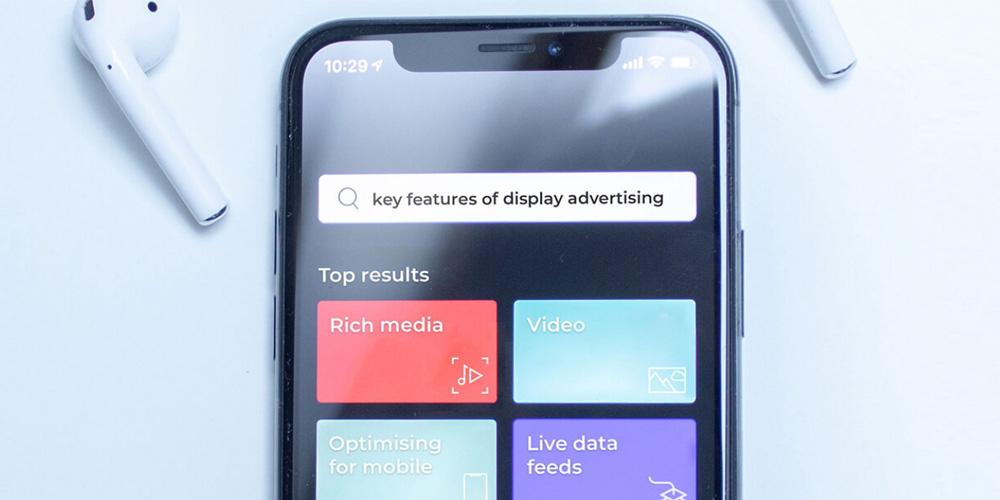
Successful display advertising is far easier than many marketers realise.
In this chapter, we focus on four features to consider when producing high performing display advertising, including:
- Using rich media to animate and engage
- Driving clicks with video
- Optimising campaigns for mobile devices
- Connecting live data fees to your display ads
1. Using rich media to animate and engage
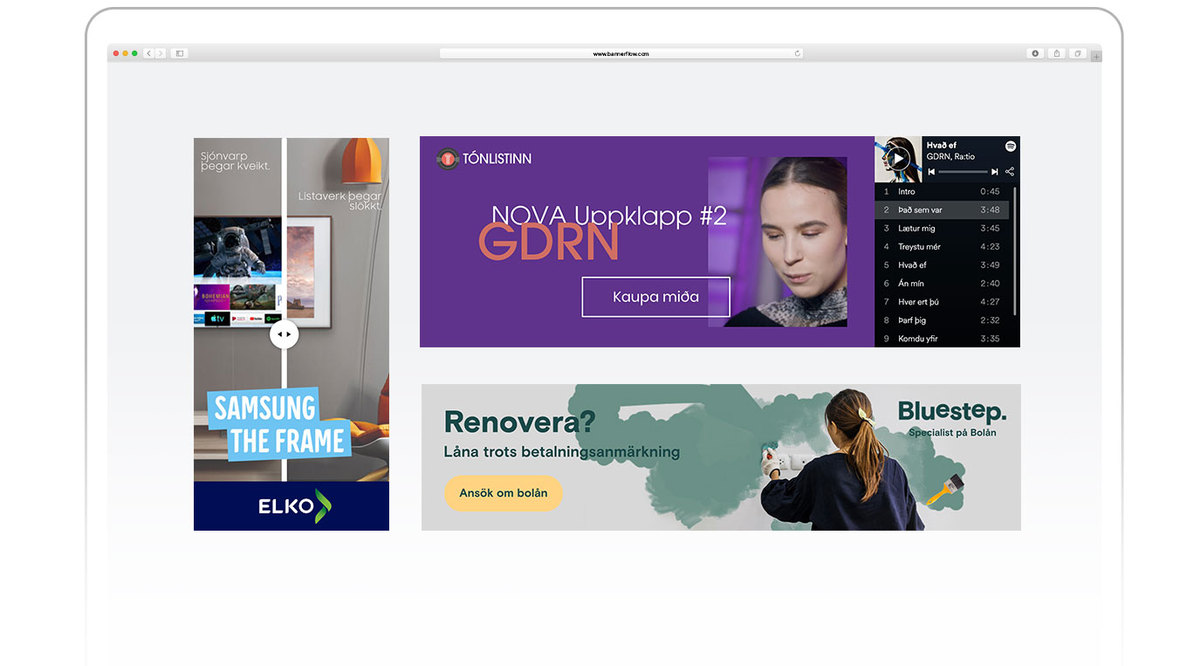
Rich media helps marketers engage consumers. Essentially, it unleashes the full potential of HTML5 and is a technology that marketers should use across all their display campaigns.
What are rich media ads?
Rich media refers to display advertising that includes features like video, audio, or other creative elements, which encourage viewers to interact and engage with your display ads.
It also works as a good alternative to video, as HTML5 animations are simple to build and smaller in file size. This is because HTML5 rich media ads are coded, and thus optimisable.
Why use rich media in display advertising?
Using rich media is a good way for your ads to stand out, as they are proven to grab viewer attention. Research from eMarketer shows that companies experience higher levels of engagement (16.2%) using rich media ads compared to static banners.
And the best thing: building rich media ads is straightforward if you have access to a CMP. These automatically code rich media ads, removing the need of a specialist developer and make them accessible to all types of marketer – not just the large agencies.
Best practice tip:
- A criticism of rich media banners is that sometimes the “weight”, or the size of the ad’s file is too large. Poorly designed rich media ads do reduce performance; slowing down pages or obscuring content. Display adverts using rich media should be optimised to IAB’s LEAN standards.
2. Driving clicks with video
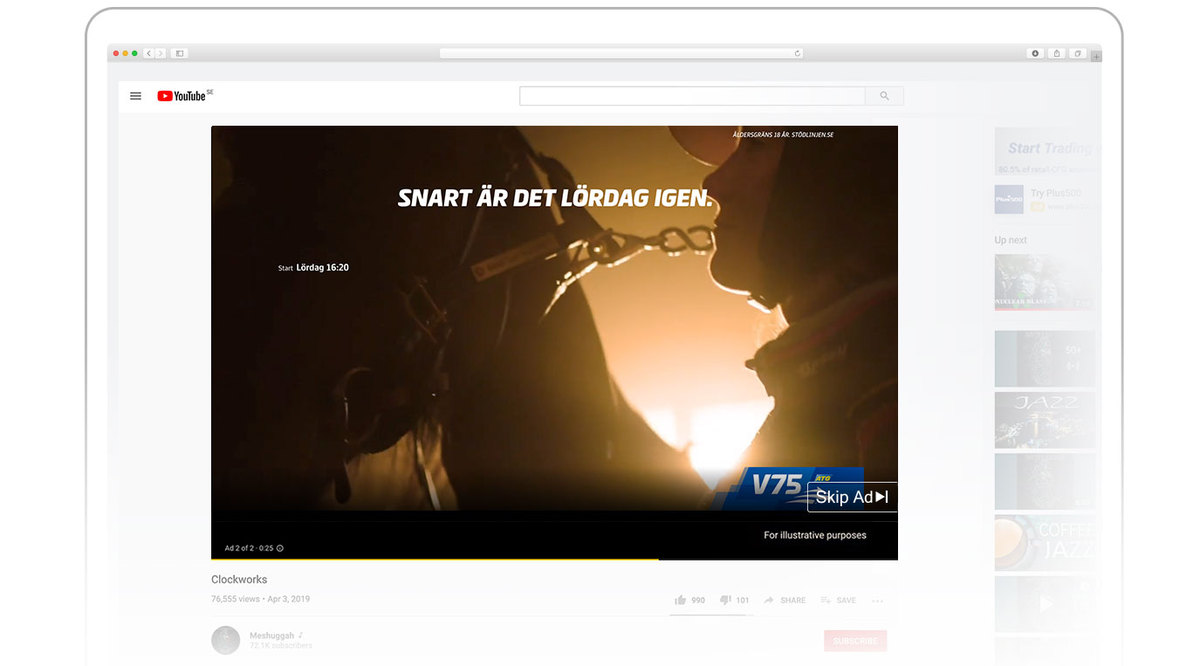
Adding a video to a display ad can naturally catch a consumer’s attention more than static images and can create continuity from campaigns on social or TV.
What is in-banner video?
In-banner video is a video clip that exists within a display ad. It uses the space provided for an HTML5 banner ad to deliver a video that is either part of a HTML5 animation or provides the viewer with the choice to click-through to a full video.
Why use video?
Viewers prefer video ads over plain static ads. In fact, in-banner video ads perform 18.4% better than static banner ads in click-through rate.
Georg Jensen’s Head of Brand and Content, Kasper Sierslev, discovered that video was an effective tool for driving engagement. “…with video, we found that our campaigns performed six times better than static ads.”
Another reason for the use of video banners is user experience. In-banner video has evolved into a respectful advertising experience. If a user doesn’t want to engage with the video ad, they scroll past it. If they do want to engage, they interact with it. Well-crafted video banners provide the viewer with a positive choice.
Best practice tips:
- In-banner video can help marketers produce successful display ads in other ways too. For example, videos can be used as backgrounds for product ads.
- While, banners can also be exported as MP4 files to be used within digital out-of-home (DOOH) or social media campaigns.
3. Optimising campaigns for mobile devices
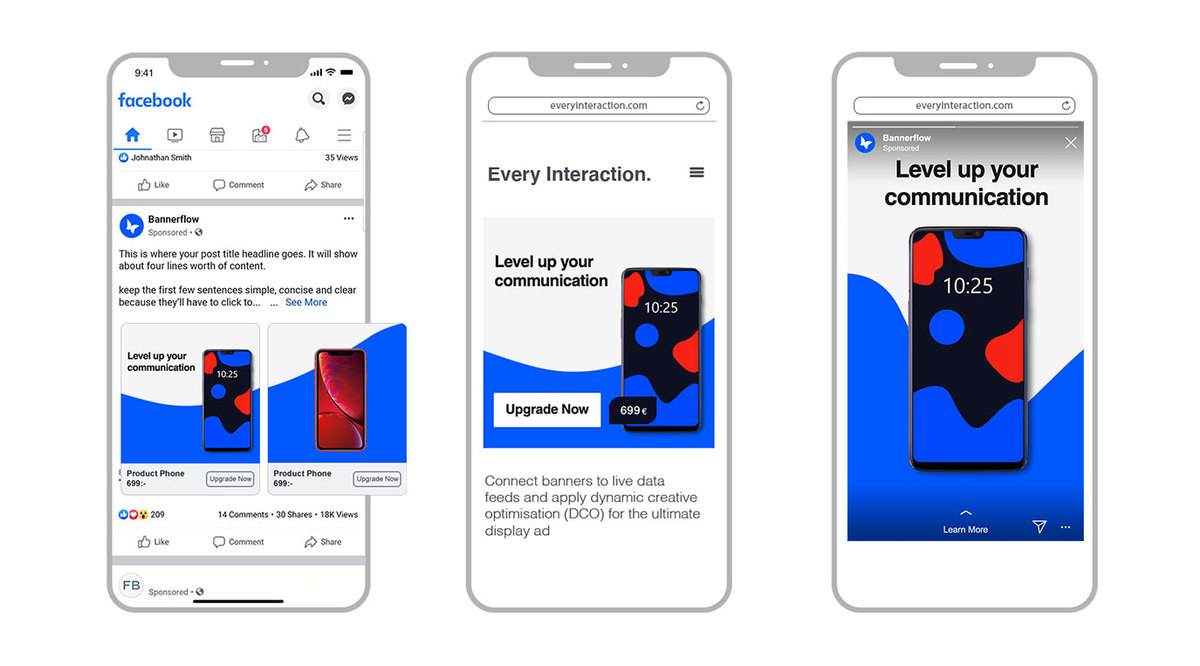
Optimising and tailoring display advertising for mobile should always be a priority. Successful display campaigns work across devices and are scheduled to take advantage of changing consumer habits. For instance, increasing mobile ad spend on weekends.
What are mobile display ads?
Mobile display ads are banners that are optimised for mobile devices. They are specific sizes of responsive HTML5 banner ads that feature copy, creative elements and images tailored for mobile interactions with consumers.
Why optimise campaigns for mobile devices?
Use of mobile devices is growing year-on-year. Therefore, using responsive display ads, and building campaigns that contain mobile sizes is essential to adapt to how viewers consume media.
Daniel Jacobsson, Bannerflow co-founder states “Today, browsers for mobiles are just as competent as those for desktop and advanced features should be embraced also in mobile ads. Really, there’s no excuse for mobile ads being more static and lifeless.”
There is also now clear evidence that mobile display ads are the preferred device during leisure hours.
To take advantage of this, and produce high performing display advertising, marketers must be able to schedule and control which ad sizes to publish and when. Again, if a marketing team has access to a CMP, building, publishing, and optimising mobile campaigns is not an issue.
Best practice tips:
- As well as designing mobile first, marketers should not be shy in using the same range of strategies, tactics, and technology they would use for desktop. Successful display campaigns work across devices and use exciting elements just as much as their desktop counterparts.
4. Connecting live data feeds to your display ads
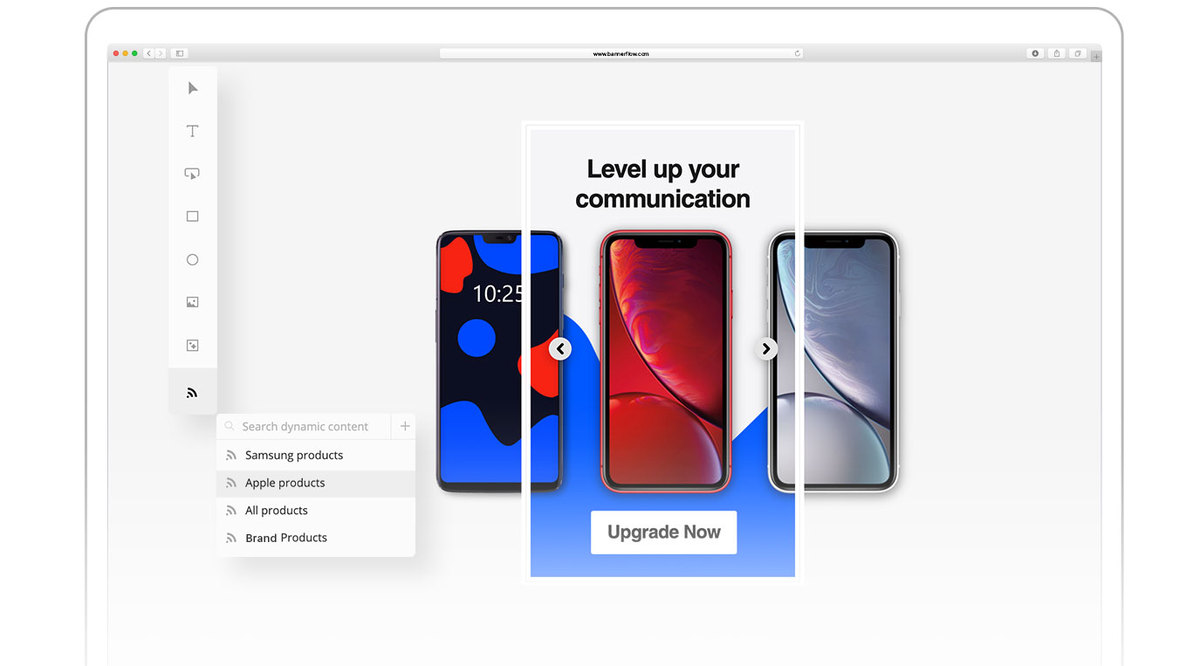
Data feeds help make even the most basic display ad more relevant. They offer the ability to present consumers with your brand’s latest information, including products, live offers, and sporting odds.
What are data feeds?
A data feed, or web feed, is essentially a spreadsheet which frequently updates content to an ad. Often, display advertising feeds are XML-files and can contain data such as words, and sentences in any language, numeric values, image URLs, and links. You can even use them to dynamically display live product inventory.
Why use data feeds in your display advertising?
Using a data feed ensures that display campaigns can remain personal, relevant and fresh. They are a brilliant way to control and display relevant ad content.
One of the first industries to use data feeds in banners was iGaming; with early adopters showing live betting odds (now standard industry best practice). However, many brands – in other industries – are still in the early stages of using data feeds, suggesting an opportunity for marketing teams in those sectors.
What makes the use of data feeds notable is their relative ease to create and control via a CMP. All you need to do is connect a data feed to your master creative and this will then show the copy, products, or offers you want displayed across all ad sizes and variants of a display campaign.
Plus, use even more sources of data and you can start to build even smarter campaigns that use dynamic creative strategies. Data feeds are an important first step towards building personalised and hyper-relevant display campaigns.
Best practice tips:
- Combining data feeds with retargeting is a great way to improve display advertising performance. It means that consumers only see the products or offers that are relevant to them.
- For example, if a consumers session has been followed on a website using cookies, a brand can serve a display ad with a data feed to show products or offers only relevant to that particular consumer.
Display advertising doesn’t have to be simple, boring, and static. With the right technology, you can create engaging and relevant ads with ease. Simply apply the same level of creativity you would on a TV or social campaign and you’ll see your performance increase.
In our next chapter, we cover how to measure campaign data and how to use that data to optimise your display campaigns.
How do you measure display advertising?
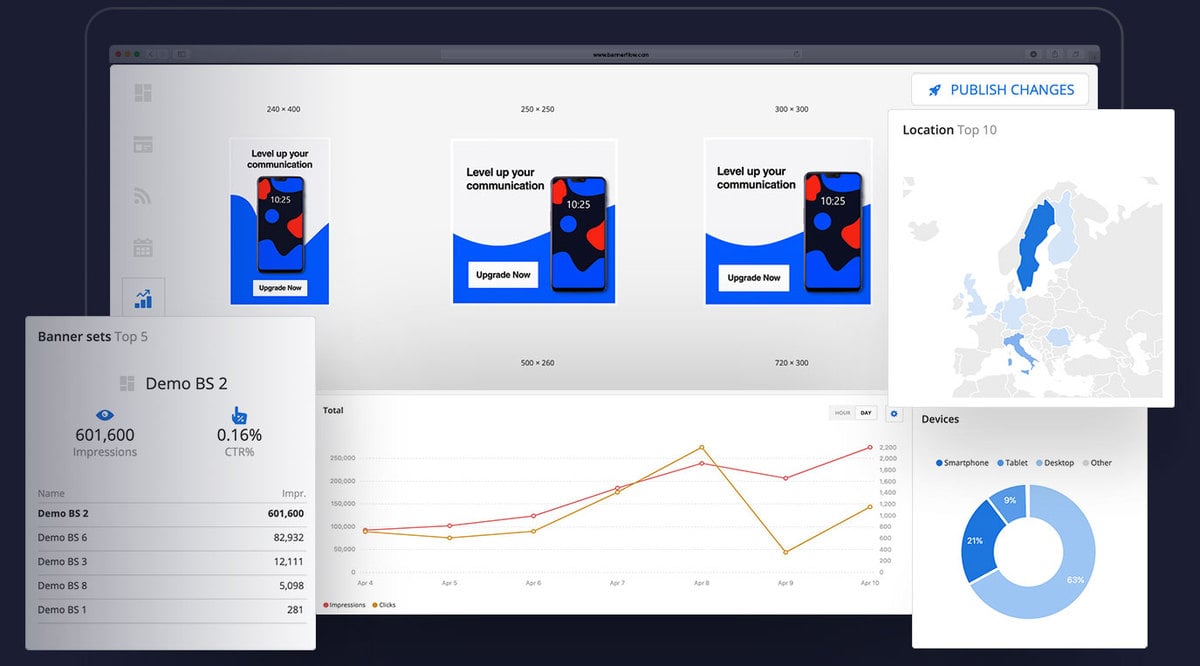
Once you have pre-optimised and published your display campaign, it is crucial that you measure its performance while it is live.
Display advertising metrics measure how often your ad is seen, how effective is it at catching the eye, and whether your ad brings in revenue for your business.
Remember! Measuring the performance of your display advertising depends on the types of campaigns you are running and your chosen KPIs. Always use the metrics most suitable for your campaign.
Here is a quick summary of the various display campaign metrics you can use.
Note: Some metrics are more reliable and useful than others for different types of campaign. Before you begin a campaign, research the best metrics to use and stick to them. Plus, make sure you have access to reliable and transparent data for your ad analytics.
What is a good click-through rate (CTR) for display advertising?

This is a common question that many digital marketers ask themselves, and it is one that can vary a lot.
Why is CTR such an important metric?
In its simplest form, click-through rate measures how often people who view an ad end up clicking on it.
It is a useful metric for display advertising as it is a clear indicator of engagement with a potential consumer. What’s more, the quality of the imagery, ad positioning, copy, and many other elements that impact CTR can be controlled and altered by the advertiser.
CTR can vary a lot between display advertisers
Looking at data from the Google Display Network, the average CTR can vary widely, with the benchmark across all ad formats and placements for a display ad CTR around 0.05%.
Furthermore, the CTR for different industries and organisations can vary because audiences for different campaigns consume display advertising in different ways.
For example, a static brand awareness campaign for a brand advertising the latest update to a piece of office software will have a lower CTR compared to a dynamic travel ad featuring in-banner video and real-time product offers.
How can a Creative Management Platform (CMP) help users achieve a better CTR?
The best way to achieve a good CTR in display advertising (alongside a good ROI) is to use a creative management platform (CMP).
The fact is, being able to produce display advertising with impact is a crucial way of achieving a good CTR. What’s more, the key to checking a higher impact within display advertising is by being both data-driven and creative; a strategy a CMP assists with greatly.
Note: Different formats of display ad have different CTRs too. For example, large sizes, such as the leaderboard (728×90) will achieve a better CTR because of their prominent positions and size on a webpage.
Why optimise display advertising before publishing?
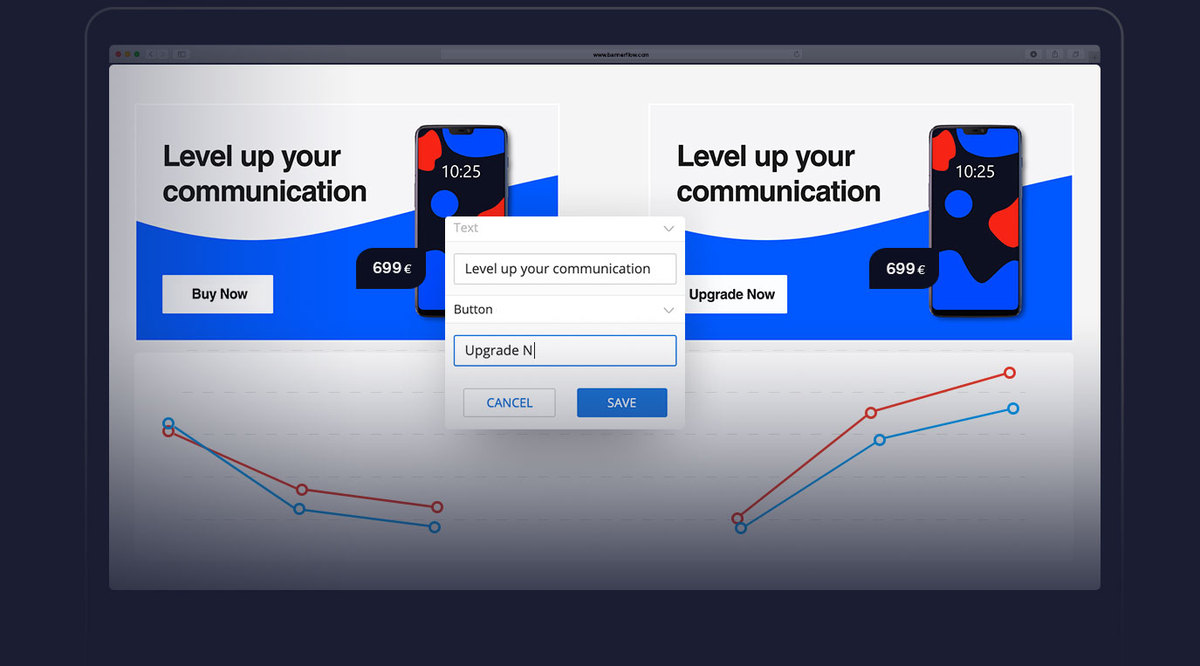
Reason 1: Avoid being rejected by ad networks
Ad networks have strict requirements that display ads must follow. Expect a banner set to be rejected if an HTML5 animation exceeds 15 seconds, or an ad file size exceeds set limits. Therefore, it is critical that all the ads you upload adhere to the requirements of the ad networks you intend to use and avoid unnecessary repetitive design tasks.
Reason 2: Increase the speed and efficiency of your ads
Another thing to note is that an ad that is too “heavy” does not perform. Text, images, or code that causes an ad to contain more than 150 kilobytes damages the browsing experience of consumers.
Moreover, the IAB emphasizes that all display ads must load fast, and contain non-disruptive content. Basically, the smaller the file size of your ad, the better!
Reason 3: Target viewers with refined creative
Use data and previous campaign performance to make your creative decisions. Take the time to create hypotheses for the creative choices you make in your display ads.
Always use this best practice. Yet, sometimes this is not enough to predict how your ad will perform. Try to use your own data and research to learn what works specifically for a campaign or a certain audience.
Reason 4: Save time and save budget
By avoiding issues with ad networks, adopting the IAB’s LEAN ad guidelines, and designing your ads with hypotheses you ultimately save on production time and budget.
Optimising production processes and removing repetitive tasks is the first step towards improved ad performance and a better ROI.
What is the best practice of optimising live display ads?

Once you have published a display campaign, your work does not end there. For many marketers this is only the beginning of a display strategy.
For example, it’s important to analyse the effectiveness of your campaigns. Measure campaign costs, conversion rates and continually A/B test to determine what imagery and messaging is working for your brand.
Tip: Measure conversion rates
It goes without saying but both during, and at the end of your campaign, measure the conversion rate of your campaign.
Remember, a conversion is not necessarily a consumer transaction and can mean whatever you have set for your display campaign. For example, it may be a charity seeking sign-ups from volunteers for life-saving courses.
Tip: Speed and moment marketing boosts performance
The world never stops turning and the day your campaign launches could be very different to the one you planned weeks ago. Therefore, being able to react and edit published ads in real-time, across the web, is now a necessity.
Use a CMP to control your display ads and you can update entire campaigns in an instant. Whether counteracting a competitors offer, or exploiting a unique opportunity, or simply removing a copy error – it’s a strategy that saves you time and money.
Tip: Build a post-click landing page
Remember! Do not forget to build a post-click landing page to link to. Studies have shown that creating a visual link between ads and landing pages creates a sense of continuity and improves results.
Tip: Test your ad creative
Testing variations of ad creative is the ultimate best practice. And if marketers use a CMP, they have access to live ad analytics, and can update ads in real-time.
Previously, advanced display ad testing and live optimisation were either too slow or too expensive to work effectively. However, in-house marketing teams using the right ad tech can now perform what was once a complex process with ease.
How do you A/B test display campaigns?
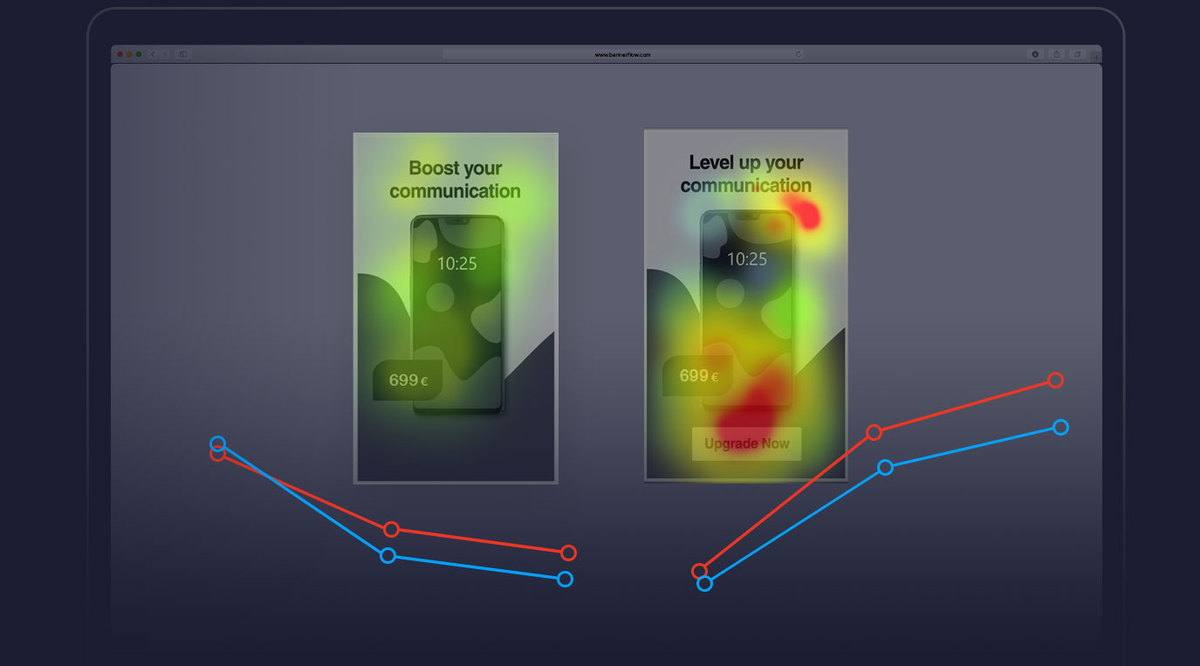
A/B testing is the most common form of testing different variations of ad creative. It is proven to boost performance and is a display campaign optimisation strategy practised by many high-performing brands.
What is A/B testing?
A/B testing is simple. You test two variants of the same display ad, with slightly different creative. For example: CTA, image, or variation of copy. You then measure which ad achieves better performance. You then begin again with another element.
The basic process of A/B testing
Ján Juriček, Bannerflows own display advertising expert, describes the basic process of A/B testing in six steps:
- Create the A version of your display ad, in all the sizes required for your campaign.
- Duplicate the A version to create a B variant of the set.
- Change the copy, image, CTA colour, etc, to create a design variation for your B ads. But remember to test only one element at a time!
- Next, publish both versions simultaneously and set the display frequency to 50/50.
- Use analytics data to compare and measure the performance of the two versions. However, only do this after you have sufficient impression data to notice performance trends.
- Finally, adjust the display frequency accordingly. For example, if the B version performing better then set its frequency to 60-70%.
Note: When A/B testing, it is best practice to keep audiences separate. Plus, any results you use should always be based on post-view conversions. This way your results are transparent and correct.
The ability to analyse and optimise display advertising is an essential skill for in-house marketers. What’s more, if you measure performance, analyse data, and optimise you will achieve a better ROI.
A/B testing is a strategy that with the right tools is easy to do too. Through using ad tech such as a creative management platform, or CMP, even the smallest in-house team can produce advanced display advertising that performs.
Why do you need to analyse display advertising transparently?
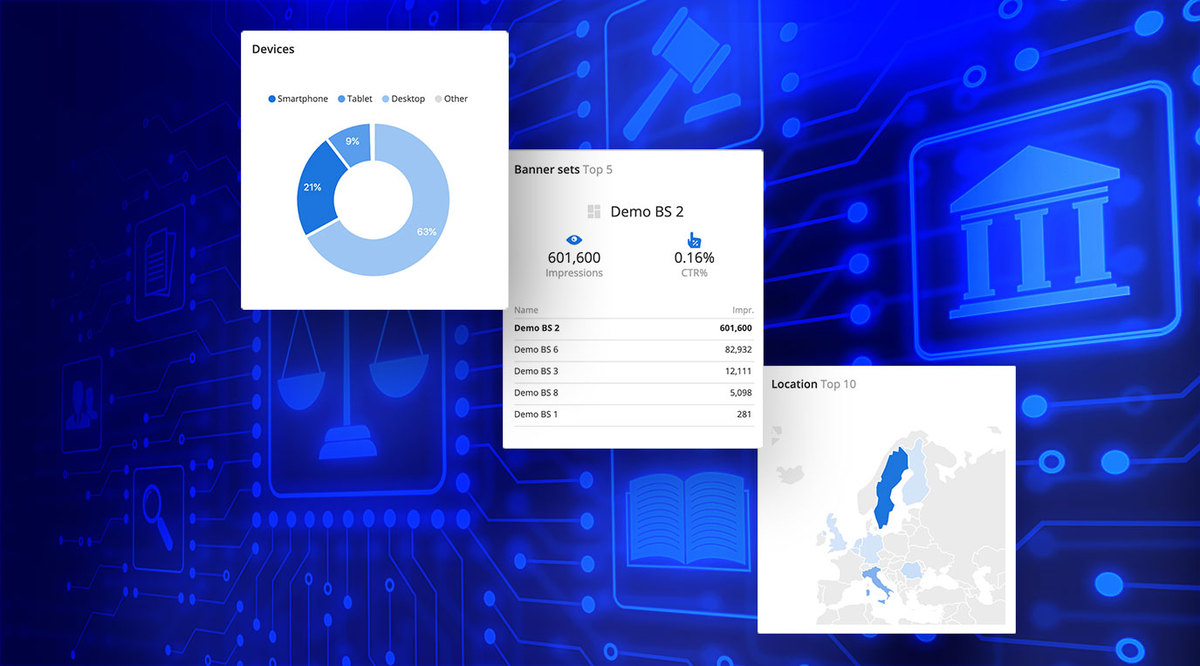
A key to successfully measuring performance is to use transparent and reliable data. Without accurate performance data, it is impossible for marketers to measure and analyse the success of a display ad.
What is transparency in display advertising?
Transparency is knowing your display ad performance is correct. It is trusting your data provider, or agency, or in-house team to only use data that is real and not flawed.
This should be easy but that isn’t always the case. Indeed, according to a recent survey of European marketers, 87% were concerned with the transparency level of media agencies!
For digital marketers that want efficiency, agility and a better ROI – none of this is possible without live transparent data (and a platform to use it).
How can you achieve transparency?
Having total control over your digital advertising processes is step one of gaining transparency over your display advertising.
Step 1: Take your marketing in-house
In a recent report on the state of in-house marketing, we learnt that many marketers in Europe reported moving some – if not all – of their marketing in-house in an effort to increase transparency.
By having full ownership over your production and analytics, you can see there and then how your ads are performing, and how to make adjustments.
However, If you’re not ready to move your display advertising in-house there are simple adjustments you make to your brand-agency relationship.
For example, encourage openness and real-time oversight on how your ads are performing and make sure they keep the time it takes to amend an ad down to a minimum.
Step 2: Work with a creative management platform (CMP)
To get the most out of your data – a creative management platform such as Bannerflow provides you with transparency over both your creative production and ad analytics.
Since the production/editing time is reduced to a minimum, there’s virtually nothing stopping you from making real-time updates of your creatives based on their performance.